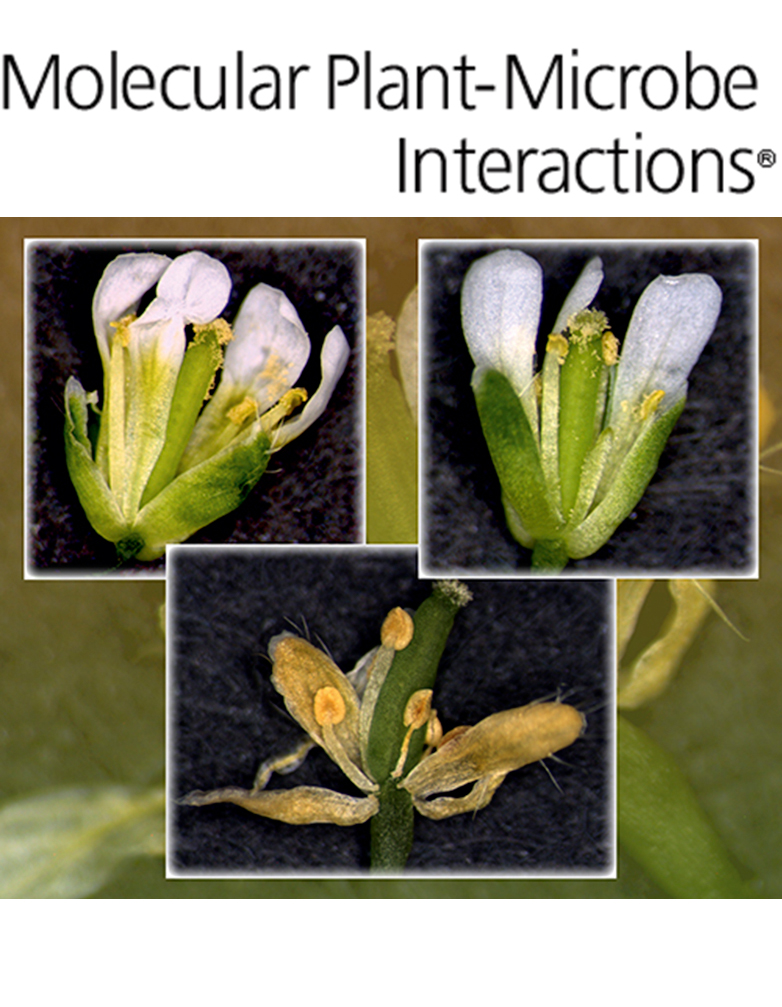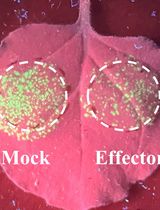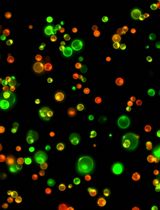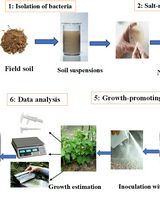- EN - English
- CN - 中文
Infection of Nicotiana benthamiana Plants with Potato Virus X (PVX)
使用马铃薯X病毒(PVX)感染本氏烟植物
发布: 2016年12月20日第6卷第24期 DOI: 10.21769/BioProtoc.2063 浏览次数: 17000
评审: Arsalan DaudiTie LiuAnonymous reviewer(s)
Abstract
Potato Virus X (PVX) is the type member of Potexvirus genus, a group of plant viruses with a positive-strand RNA genome (~6.4 kb). PVX is able to establish compatible infections in Nicotiana benthamiana, a commonly used host in plant virology, leading to mild symptoms, such as chlorotic mosaic and mottling. PVX has been widely used as a viral vector for more than two decades (Chapman et al., 1992; Baulcombe et al., 1995; Aguilar et al., 2015). It provides a feasible means for the systemic expression in plants of heterologous proteins, such as avirulence factors, proteins with pharmacological properties, etc., (Hammond-Kosack et al., 1995; Gleba et al., 2014), and also as a tool to help decipher the function of genes in plants by virus-induced gene silencing (VIGS) (Lacomme and Chapman, 2008). Two different protocols, i.e., rubbing (A) and agroinfiltration (B), that allow efficient multiplication and propagation of PVX in N. benthamiana are described here in detail. The rubbing method requires previously infected sap, and infection is achieved by inducing mechanical damages to leaf tissue, allowing viral particles to penetrate the plant surface. Agroinfiltration needs previously modified Agrobacterium to carry and deliver T-DNA with PVX sequences into the plant cell. Agrobacterium is grown until saturation and infection is established by infiltrating it into plant tissue with a syringe. Any of these two methods can be successfully applied, and the choice should be based mainly on the availability of material and time, but it is recommended to use agroinfiltration when chimeric viruses are being used.
Keywords: Potato Virus X (马铃薯X病毒)Background
PVX is transmitted by mechanical means, so the easiest and fastest way to infect plants is by rubbing the leaves with sap from infected tissue. However, since RNA viruses have high mutation rates, caution must be taken when rubbing is used as propagation method. In this regard, the number of serial passages between plants should be limited, and the inoculum should be used fresh from original stocks. To solve this inconvenience, an infectious PVX cDNA clone has been introduced into a binary T-DNA vector, which allows its easy delivery into N. benthamiana by Agrobacterium tumefaciens. Agroinfiltration should be considered as preferred method when recombinant PVX is being used, in order to prevent serial propagation of deleted viral forms from a previous experiment to the next one (Chung et al., 2007).
Materials and Reagents
- Rubbing
- 2 ml safe-lock tubes (Eppendorf, catalog number: 022363352 )
Note: This product has been discontinued. - Latex powder-free gloves (Staples, Ambitex®, catalog number: SS2072105 )
- Gauze (Fisaude. Kinefis, catalog number: 10901 )
- N. benthamiana plants at the stage of 4-6 fully expanded true leaves (see Figure 1)
- Flash frozen, infected tissue (PVX virus inoculum from DSMZ Plant Virus Collection, Reference No.: 15649, DSMZ No.: PV-0847, Leibniz Institute DSMZ-German Collection of Microorganisms and Cell Cultures)
- Liquid nitrogen
- Ice
- Sodium dihydrogen phosphate (NaH2PO4) (EMD Millipore, catalog number: 106346 )
- Di-sodium hydrogen phosphate (Na2HPO4) (EMD Millipore, catalog number: 106559 )
- Abrasive carborundum powder (CARLO ERBA Reagents, catalog number: 434786 )
- Sodium phosphate buffer (see Recipes)
- 2 ml safe-lock tubes (Eppendorf, catalog number: 022363352 )
- Agroinfiltration
- Petri dishes (Gosselin, catalog number: BP93B-102 )
- 50 ml conical centrifuge tubes (Corning, Falcon®, catalog number: 352070 )
- 13 ml centrifuge tubes (SARSTEDT, catalog number: 62.515.006 )
- 1 ml syringes, without needle (BD, catalog number: 309659 )
- 10 ml sterile pipettes (Corning, Falcon®, catalog number: 357551 )
- N. benthamiana plants (at the 4-6 leaves stage, see Figure 1)
- Agrobacterium tumefaciens (any disarmed strain, like GV3101) carrying a T-DNA binary vector with a full-length cDNA clone of PVX (Chapman et al., 1992; Lu et al., 2003, see Notes)
- Agrobacterium tumefaciens (any disarmed strain, like GV3101) carrying the empty T-DNA binary vector, as control
- Magnesium chloride (MgCl2) (EMD Millipore, catalog number: 105833 )
- 2-morpholinoethanesulfonic acid (MES) (SERVA Serving Scientists, catalog number: 29834 )
- 3’,5’-dimethoxy-4’-hydroxyaceto-phenone (Acetosyringone) (Sigma-Aldrich, catalog number: D134406 )
- Dimethyl sulfoxide (DMSO) (EMD Millipore, catalog number: 102952 )
- Tryptone (BD, BactoTM, catalog number: 211705 )
- Yeast extract (Conda, catalog number: 1702 )
- Sodium chloride (NaCl) (EMD Millipore, catalog number: 106404 )
- American bacteriological agar (Conda, catalog number: 1802 )
- Appropriate, selective antibiotics (Kanamycin and tetracycline) (Sigma-Aldrich, catalog numbers: K1377 , 87128 )
- Induction buffer (see Recipes)
- LB liquid medium supplemented with appropriate antibiotics (see Recipes)
- LB/agar medium supplemented with appropriate antibiotics (see Recipes)
- Petri dishes (Gosselin, catalog number: BP93B-102 )
- Western blot detection
- 1.5 ml safe-lock tubes (Eppendorf, catalog number: 0030120086 )
- Polyvinyl PVDF membrane (GE Healthcare, catalog number: 10600023 )
- Tris-hydroxymethyl-aminomethane (Tris) base (EMD Millipore, catalog number: 108386 )
- Hydrochloric acid (HCl) (Hydrochloric acid 37%) (EMD Millipore, catalog number: 100317 )
- Ethylenediaminetetraacetic acid (EDTA) (EMD Millipore, catalog number: 324503 )
- Lithium chloride (LiCl) (EMD Millipore, catalog number: 105679 )
- β-mercaptoethanol solution (EMD Millipore, catalog number: 805740 )
- Sodium dodecyl sulfate (SDS) (EMD Millipore, catalog number: 817034 )
- Bromophenol Blue (BPB) (Sigma-Aldrich, catalog number: 114391 )
- Glycerol (Glycerol 87% solution) (EMD Millipore, catalog number: 104094 )
- 3-hydroxy-4-(2-sulfo-4-[4-sulfophenylazo] phenylazo)-2,7-naphthalenedisulfonic acid sodium salt (Ponceau S) (Sigma-Aldrich, catalog number: P3504 )
- Acetic acid (Acetic acid glacial 100% solution) (EMD Millipore, catalog number: 100063 )
- Sodium chloride (NaCl) (EMD Millipore, catalog number: 116224 )
- Potassium dihydrogen phosphate (KH2PO4) (Sigma-Aldrich, catalog number: 60230 )
- Potassium chloride (KCl) (EMD Millipore, catalog number: 104936 )
- Acrylamide (30% Acrylamide/Bis solution, 37.5:1) (Bio-Rad Laboratories, catalog number: 1610158 )
- Rabbit anti-PVX CP antibody (LOEWE Biochemica, catalog number: 07037 )
- Goat anti-rabbit antibody conjugated with AP (Sigma-Aldrich, catalog number: A3687 )
- SigmaFastTM BCI/NBT tablets (Sigma-Aldrich, catalog number: B5655 )
- Protein extraction buffer for Western blot (see Recipes)
- 2x Laemmli solution for western blot (see Recipes)
- Ponceau S solution (see Recipes)
- Blocking solution (see Recipes)
- 10x PBS, pH 7.4 (see Recipes)
- 1.5 ml safe-lock tubes (Eppendorf, catalog number: 0030120086 )
Equipment
- Common equipment
- Rubbing
- Mortar and pestle (Silico & Chemico Porcelain SE)
- Refrigerated table microcentrifuge (Hettich Lab Technology, model: Mikro 200R )
- Pacisa Weighing Balances (Precisa Gravimetrics, model: XB620C-G )
- Mortar and pestle (Silico & Chemico Porcelain SE)
- Agroinfiltration
- 28 °C incubator for plate culture (JP Selecta, model: 2001258 )
- 28 °C refrigerated incubator shaker (Eppendorf, New Brunswick Scientific, model: 4330 )
- Refrigerated centrifuge for 13 ml tubes (Hettich Lab Technology, model: Universal 320R )
- 600 nm wavelength-sensitive spectrophotometer (Eppendorf, model: Bio Photometer 6131 000.012 )
- 28 °C incubator for plate culture (JP Selecta, model: 2001258 )
- Western blot detection
- Blue polypropylene, pellet pestles for 1.5 Eppendorf tubes (Sigma-Aldrich, catalog number: Z359947 )
- Thermomixer (Eppendorf, catalog number: 5384000012 )
- Cork-borer set (Sigma-Aldrich, catalog number: Z165220 )
- Blue polypropylene, pellet pestles for 1.5 Eppendorf tubes (Sigma-Aldrich, catalog number: Z359947 )
Procedure
文章信息
版权信息
© 2016 The Authors; exclusive licensee Bio-protocol LLC.
如何引用
Aguilar, E., del Toro, F. J., Chung, B., Canto, T. and Tenllado, F. (2016). Infection of Nicotiana benthamiana Plants with Potato Virus X (PVX). Bio-protocol 6(24): e2063. DOI: 10.21769/BioProtoc.2063.
分类
植物科学 > 植物免疫 > 病害生物测定
植物科学 > 植物免疫 > 宿主-细菌相互作用
您对这篇实验方法有问题吗?
在此处发布您的问题,我们将邀请本文作者来回答。同时,我们会将您的问题发布到Bio-protocol Exchange,以便寻求社区成员的帮助。
Share
Bluesky
X
Copy link













